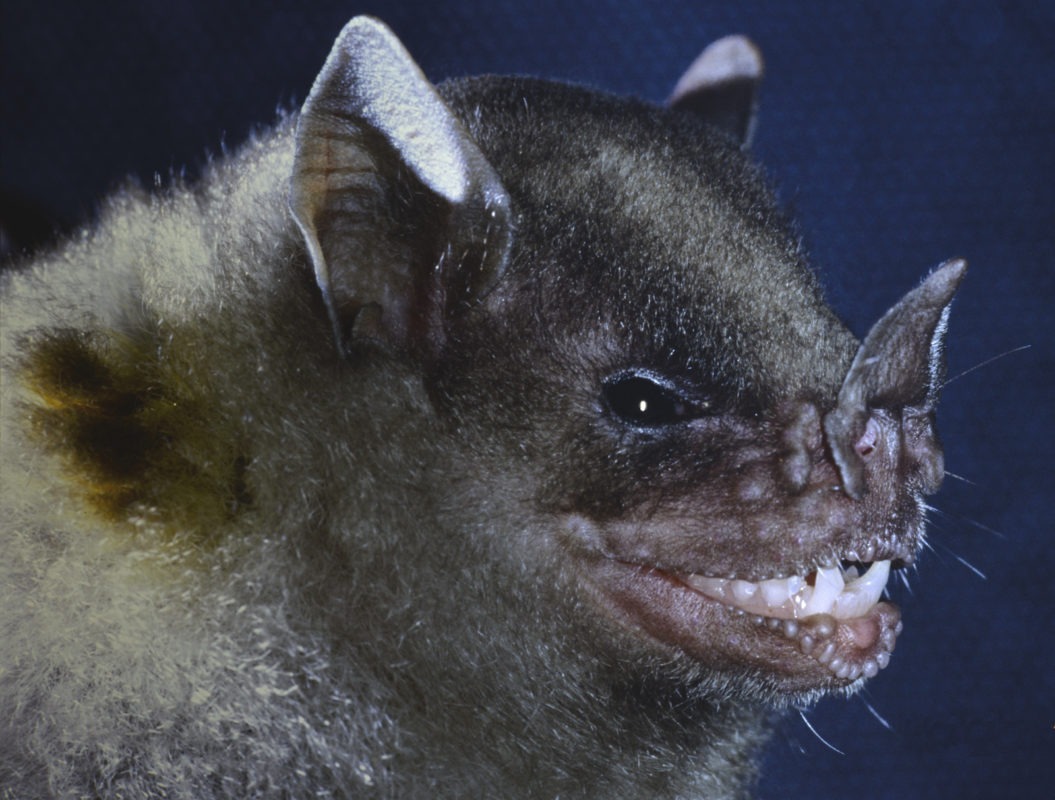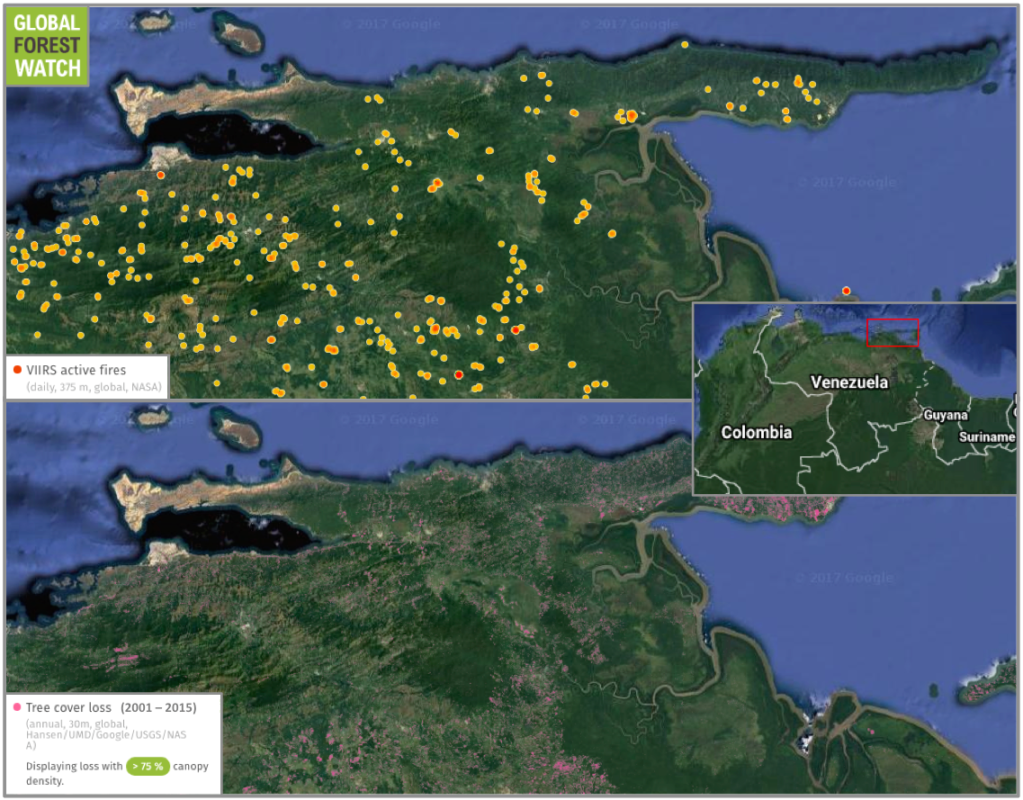- Using genetic and morphologic comparisons, scientists uncovered a new leaf-nosed bat species they named Sturnia adrianae. The species inhabits montane forest in northern Venezuela and Colombia.
- The species is comprised of two subspecies, one of which is restricted to an isolated mountain range in northeastern Venezuela where human-caused fires are common.
- The study’s lead author recommends increasing conservation and scientific attention for the area to preserve bat habitat, safeguard water supplies, and help prevent landslides like those that recently killed at least 250 people in Mocoa, Colombia.
Scientists have uncovered a new species of bat in the mountains of Venezuela and Colombia. But its forest habitat is under big threat from slash-and-burn agriculture, and its discoverers are urging more conservation attention be paid to the region.
Recognized by their short faces, bumpy lips, and peculiar nose-flaps, leaf-nosed bats are common throughout much of Central and South America. But while they’re all members of the same family (Phyllostomidae), leaf-nosed bat species don’t follow one path when it comes to how and what they eat. Most are insectivorous, while others eat frogs, birds, and even other bats. One species, the famed vampire bat (Desmodus rotundus), lives entirely off the blood of larger animals, lapping from small cuts it makes while its victim sleeps.
Still other leaf-nosed bats pursue a vegetarian lifestyle, dining on fruit, nectar, and pollen. One of these fruit-eating – or “frugivorous” – groups is the Sturnia genus, which holds the record for the most species. Sturnia, commonly called yellow-shouldered bats, received yet another species recently, after researchers from institutions in Venezuela and Ecuador looked more closely at the genetics and bones of bats in northern Colombia and Venezuela.
The researchers discovered that two groups of bats that had been classified as a certain species were in fact members of another species unknown to science. They describe this new species, which they named Sturnia adrianae, in a study published recently in the journal Zootaxa. The species had previously been lumped into Sturnia ludovici.

Jesús Molinari, a researcher at Venezuela’s Universidad de Los Andes and lead author of the study, says the new species was only uncovered now because the regions in which it lives have lacked thorough scientific examinations.
“As is the case with many other South American mammals, populations of this bat species had a doubtful taxonomic status,” Molinari told Mongabay. “The species was not discovered before owing to the lack of studies at the morphological and genetic levels of populations of members the genus Sturnira in Venezuela and Colombia.”
The researchers compared the genetics and morphology, or physical characteristics, of Sturnira bats in the region, using specimens from museum collections. They found distinctions in both, and also noticed S. adrianae seems to be highly sexually dimorphic – meaning that there are clear differences between males and females – which also differentiates it from the other Sturnira species they were using in their comparison.
Molinari and his colleagues went further than the species level in their description, dividing S. adrianae into two subspecies: S. a. adrianae and S. a. caripana. The former is larger and was found in western and north-central Venezuela, as well as across the border in Colombia; S. a. caripana is smaller both in size and distribution, with its range restricted to a small area of northeastern Venezuela.
“For decades, an adequate number of specimens of the larger new subspecies were available in scientific collections without being studied,” Molinari said. “On the other hand, specimens of the smaller new subspecies were and still are rare in scientific collections owing to the paucity of faunal inventories in the beautiful and endangered forests of the isolated mountains of northeastern Venezuela.”
Molinari and his colleagues found S. a. caripana is restricted to the Turimiquire Massiff, an isolated mountain range to the east of the broader range of S. a. adrianae. According to Molinari, the area is subject to slash-and-burn clearing, a technique in which farmers burn vegetation to convert an area for crop production.
“A major problem is wildfires caused by a traditional culture of slash-and-burn agriculture. As a part of this culture, people of the region burn vegetation during the dry season even for no apparent reason,” Molinari said. “The mountains of the region have very steep slopes, which facilitate the spreading of highly destructive fires uphill. There is also an uncontrolled expansion of agriculture, both slash-and-burn and modern, in highlands that have been designated as national parks to preserve water supplies.”
Data from the University of Maryland indicate Turimiquire Massiff lost around 6 percent of its tree cover between 2001 and 2015, while data from NASA show nearly 400 fires burning in the range in the week between March 30 and April 6, 2017.

The researchers recommend S. a. caripana be considered Vulnerable by the IUCN, citing “an extent of occurrence less than 20000 [square kilometers], a declining extent and quality of habitat, and a fragmentation and reduction of subpopulations.” For the more widespread S. a. adrianae, they recommend an IUCN listing of Least Concern.
Molinari says the outlook for S. a. caripana may be improved through more research in the region, as well as education outreach in the communities within and around Turimiquire Massiff.
“More support for faunal inventories and scientific research, which in Venezuela are difficult to carry out owing to lack of funding,” he said. “Educational campaigns are needed to avoid wildfires, and to promote the understanding and respect for national parks and their floras and faunas.”
Molinari added that not only may this help the bats, but it may also help safeguard human lives, referencing the catastrophic March 31 mudslides that reportedly killed at least 250 people in Mocoa, Colombia. Scientists contribute the event, in part, to deforestation of the surrounding countryside.
“People must understand that without the forests supposed to be protected by national parks not only a unique biodiversity will be lost,” he said, “but also the supply of water for agriculture and human consumption will dwindle and catastrophic mudslides like the recent one at the city of Mocoa in Colombia will become frequent.”
Citations:
MOLINARI, J., BUSTOS, X. E., BURNEO, S. F., CAMACHO, M. A., MORENO, S. A., & FERMÍN, G. (2017). A new polytypic species of yellow-shouldered bats, genus Sturnira (Mammalia: Chiroptera: Phyllostomidae), from the Andean and coastal mountain systems of Venezuela and Colombia. Zootaxa, 4243(1), 75-96.
Hansen, M. C., P. V. Potapov, R. Moore, M. Hancher, S. A. Turubanova, A. Tyukavina, D. Thau, S. V. Stehman, S. J. Goetz, T. R. Loveland, A. Kommareddy, A. Egorov, L. Chini, C. O. Justice, and J. R. G. Townshend. 2013. “High-Resolution Global Maps of 21st-Century Forest Cover Change.” Science 342 (15 November): 850–53. Data available on-line from:http://earthenginepartners.appspot.com/science-2013-global-forest. Accessed through Global Forest Watch on April 06, 2017. www.globalforestwatch.org
NASA FIRMS. “VIIRS Active Fires.” Accessed through Global Forest Watch on April 06, 2017. www.globalforestwatch.org
FEEDBACK: Use this form to send a message to the editor of this post. If you want to post a public comment, you can do that at the bottom of the page.